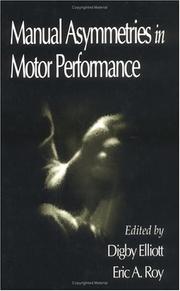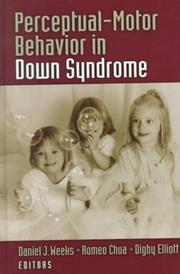| Listing 1 - 7 of 7 |
Sort by
|

ISBN: 9780080867397 0080867391 1281789399 9781281789396 9786611789398 9780444888167 0444888160 Year: 1992 Publisher: Amsterdam New York New York, N.Y., U.S.A. North-Holland Distributors for the U.S. and Canada, Elsevier Science Pub. Co.
Abstract | Keywords | Export | Availability | Bookmark
 Loading...
Loading...Choose an application
- Reference Manager
- EndNote
- RefWorks (Direct export to RefWorks)
Since the classic studies of Woodworth (1899), the role ofvision in the control of movement has been an importantresearch topic in experimental psychology. While many earlystudies were concerned with the relative importance of visionand kinesthesis and/or the time it takes to use visualinformation, recent theoretical and technical developmentshave stimulated scientists to ask questions about howdifferent sources of visual information contribute to motorcontrol in different contexts. In this volume, articles arepresented that provide a broad coverage
Perceptual-motor processes. --- Motion perception (Vision) --- Visual perception. --- Kinesiology. --- Sensory-motor processes --- Movement, Psychology of --- Perception --- Cinesiology --- Human mechanics --- Motor ability --- Optics, Psychological --- Vision --- Visual discrimination --- Movement perception (Vision) --- Speed perception --- Visual perception --- Psychological aspects --- Kinesiology --- Perceptual-motor processes --- Kinesthesis --- Motion Perception --- Visual Perception --- 612.8 --- Movement Perception --- Perception, Motion --- Perception, Movement --- Motion Capture --- Kinesthetic Sense --- Movement Sensation --- Kinesthesia --- Kinestheses --- Kinesthesias --- Kinesthetic Senses --- Movement Sensations --- Visual Processing --- Perception, Visual --- Processing, Visual --- Vision, Ocular --- Zenuwstelsel. Zintuigen. Motorische neurowetenschappen
Digital
ISBN: 9780080867397 0080867391 1281789399 9781281789396 Year: 1992 Publisher: New York, N.Y., U.S.A. Distributors for the U.S. and Canada, Elsevier Science Pub. Co
Abstract | Keywords | Export | Availability | Bookmark
 Loading...
Loading...Choose an application
- Reference Manager
- EndNote
- RefWorks (Direct export to RefWorks)
Since the classic studies of Woodworth (1899), the role of vision in the control of movement has been an important research topic in experimental psychology. While many early studies were concerned with the relative importance of vision and kinesthesis and/or the time it takes to use visual information, recent theoretical and technical developments have stimulated scientists to ask questions about how different sources of visual information contribute to motor control in different contexts. In this volume, articles are presented that provide a broad coverage of the current research and theory on vision and human motor learning and control. Many of the contributors are colleagues that have met over the years at the meetings and conferences concerned with human movement. They represent a wide range of affiliation and background including kinesiology, physical education, neurophysiology, cognitive psychology and neuropsychology. Thus the topic of vision and motor control is addressed from a number of different perspectives. In general, each author sets an empirical and theoretical framework for their topic, and then discusses current work from their own laboratory, and how it fits into the larger context. A synthesis chapter at the end of the volume identifies commonalities in the work and suggests directions for future experimentation.
Book
ISBN: 9780736074759 0736074759 Year: 2010 Publisher: Champaign Human kinetics
Abstract | Keywords | Export | Availability | Bookmark
 Loading...
Loading...Choose an application
- Reference Manager
- EndNote
- RefWorks (Direct export to RefWorks)
Motor Activity --- Goals. --- Intention. --- Psychomotor Performance --- Visual Perception --- Perceptual-motor processes. --- Motion perception (Vision) --- Visual perception. --- Processus perceptivomoteurs --- Perception du mouvement (Vision) --- Perception visuelle --- physiology. --- Perceptual-motor processes --- Goals --- Intention --- Activité motrice --- Perception spatiale --- Mouvement --- physiology --- 612.8 --- Fysiologie --- Zenuwstelsel --- Bewegen --- Motoriek --- Zenuwstelsel. Zintuigen. Motorische neurowetenschappen --- Visual perception --- Optics, Psychological --- Vision --- Perception --- Visual discrimination --- Sensory-motor processes --- Movement, Psychology of --- Movement perception (Vision) --- Speed perception --- Psychological aspects

Abstract | Keywords | Export | Availability | Bookmark
 Loading...
Loading...Choose an application
- Reference Manager
- EndNote
- RefWorks (Direct export to RefWorks)
612.8 --- Zenuwstelsel. Zintuigen. Motorische neurowetenschappen --- Cerebral dominance. --- Laterality. --- Motor ability. --- Cerebral dominance --- Laterality --- Motor ability --- Agility --- Coordination, Muscular --- Dexterity --- Manual dexterity --- Manual skill --- Motor control (Physiology) --- Motor dexterity --- Motor skill --- Motor skills --- Muscular coordination --- Skills, Motor --- Ability --- Movement, Psychology of --- Kinesiology --- Mechanical ability --- Psychophysiology --- Dual-brain psychology --- Dominance, Cerebral --- Functional asymmetry (Brain) --- Hemispheric dominance (Brain) --- Lateralization (Brain) --- Left and right brain --- Right and left brain --- Cerebral hemispheres --- Whole brain learning
Book
Abstract | Keywords | Export | Availability | Bookmark
 Loading...
Loading...Choose an application
- Reference Manager
- EndNote
- RefWorks (Direct export to RefWorks)
To interact with the environment, an individual must code, store, and translate spatial information into the appropriate motor commands for achieving an outcome. Working from this premise, Vision and Goal-Directed Movement: Neurobehavioral Perspectives discusses how visual perception, attention, and memory are linked to the processes of movement preparation and execution. With contributions from active researchers in movement science, Vision and Goal-Directed Movement presents the latest theories on the utilization of vision in goal-directed movement control. As a resource for motor control and motor learning researchers, students, educators, and clinicians, Vision and Goal-Directed Movement offers the following: Comprehensive coverage of current behavior-based literature on the visual control of goal-directed movement; A systematic explication of the sensory and physiological processes and systems responsible for fast, accurate, and efficient performance; A solid foundation for further study of the sensory and neural systems responsible for precise goal-directed behavior; A discussion of how current research on vision and goal-directed movement can assist in creating efficient and safe work environments. Using research informed by neural imaging and magnetic brain stimulation, this text provides readers with a better understanding of the neural foundations for goal-directed movement, illustrates the flexibility of the human visuomotor system, and discusses how regulation of movements depends on the learning and developmental history of the performer. It begins by reviewing the works of R.S. Woodworth and the influence of his theories on current research. The majority of the chapters in the first section of the book take a behavioral and process-oriented approach to exploring goal-directed movement. The text then explores the sensory and neural foundations for goal-directed action, including issues related to both pursuit and saccadic eye movements as well as discussion of the specialization of various cortical systems for the regulation of movement. Especially relevant to professionals and scientists concerned with skill instruction and rehabilitation, the final part of the text provides a review of recent research on how and why limb control changes occur with practice and development. In addition, Vision and Goal-Directed Movement considers how the research presented can maximize precision, efficiency, and safety in workspace design. Vision and Goal-Directed Movement: Neurobehavioral Perspectives adds a unique offering to the literature base for motor behavior, demonstrating how advances in both behavioral and neurophysiological methods can inform theories related to the biological systems contributing to skilled performance.
Perceptual-motor processes. --- Motion perception (Vision) --- Visual perception.

ISBN: 0880119756 9780880119757 Year: 2000 Publisher: Champaign Human Kinetics
Abstract | Keywords | Export | Availability | Bookmark
 Loading...
Loading...Choose an application
- Reference Manager
- EndNote
- RefWorks (Direct export to RefWorks)
Perceptual-Motor Behavior in Down Syndrome is a comprehensive collection of contemporary research and provides readers a window into the behavioral variability exhibited by this special group. Now you can apply this research to circumvent, or at least minimize, some of the general and specific processing challenges associated with Down syndrome. Internationally recognized contributors from 10 different countries cover aspects of sensory, cognitive, and movement processes in infants, children, and adults with Down syndrome. Specifically addressed are the differences and similarities among persons with Down syndrome, people with other disabilities, and non-disabled people. Contributors present fellow researchers, educators, parents, and students with an increased understanding that perceptual-motor behavior in Down syndrome is often adaptive and appropriate. Use this up-to-date resource in current program planning, educational initiatives, and future research efforts. (Bron: covertekst)
Down syndrome. --- Perceptual-motor processes --- Perception --- Down Syndrome --- Down, Syndrome de --- Processus perceptivomoteurs --- Perceptual-motor processes. --- 032444.jpg --- Down-syndroom --- Mongolen: motoriek --- Down syndrome --- Sensory-motor processes --- Movement, Psychology of --- 21 trisomy --- Down's syndrome --- Mongolism --- Mongolism (Disease) --- Trisomy 21 --- Human chromosome abnormalities --- Intellectual disability --- Syndromes --- Human chromosome 21 --- Perception. --- Down Syndrome.
Dissertation
Year: 2014 Publisher: Leuven KU Leuven. Doctoral school Biomedical sciences
Abstract | Keywords | Export | Availability | Bookmark
 Loading...
Loading...Choose an application
- Reference Manager
- EndNote
- RefWorks (Direct export to RefWorks)
Elderly people often encounter problems in visuomotor interaction with their environment due to substantial declines in the functioning of their sensory-motor and cognitive systems. As a result of this deterioration, the elderly seem to use visual feedback for online corrections in manual aiming more so than younger people do. Studies of age-related differences in discrete aiming tasks have indicated that older adults spend more time decelerating their goal-directed movements when homing-in on the target to achieve the same degree of accuracy. As the deceleration phase is associated with feedback-based adjustments to the ongoing movement, it has been suggested that older adults are more dependent on visual feedback to monitor and control goal-directed movements. Accordingly, adequate visuomotor integration is increasingly important for everyday functioning of the elderly. Consequently, it seems that elderly need to find a new strategy to cope with the aforementioned declines in performance by employing a new optimal combination of open- and closed-loop control (related to central planning processes and feedback-based adjustments, respectively), counting less on the former and more on the latter. To date, no attempt has been made to document age-related changes in the visual control of elderly during goal-directed actions. How and to what extent the elderly actually compensate for these declines remains therefore an intriguing question. In this view, the principal aim of this project will be to examine how visuomotor control changes as a result of aging based on detailed recording of eye-movement patterns in parallel to those of the hand trajectory. The main hypothesis is: elderly adopt a play-it-safe strategy in visually guided movements by relying relatively more on the use of online visual feedback compared to young adults. In addition, we will also study the neural mechanisms that are involved in this open- and closed-loop control, using non-invasive neurophysiological techniques like transcranial magnetic stimulation (TMS). Finally, it is expected that physical activity will have a positive effect on the aging process and therefore these age-related differences in strategy should be less significant in active older adults.
| Listing 1 - 7 of 7 |
Sort by
|

 Search
Search Feedback
Feedback About
About Help
Help News
News